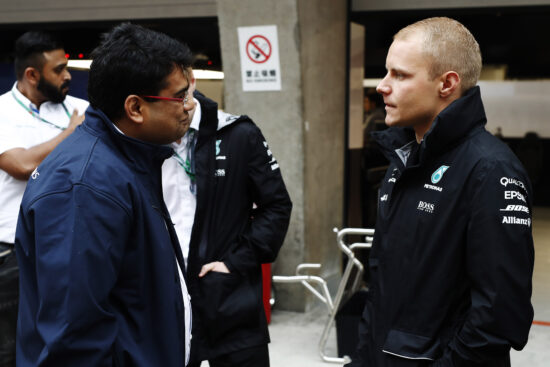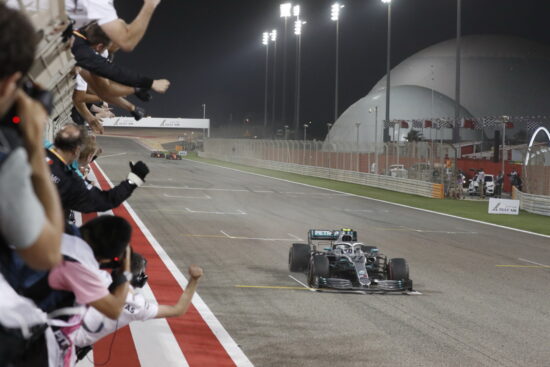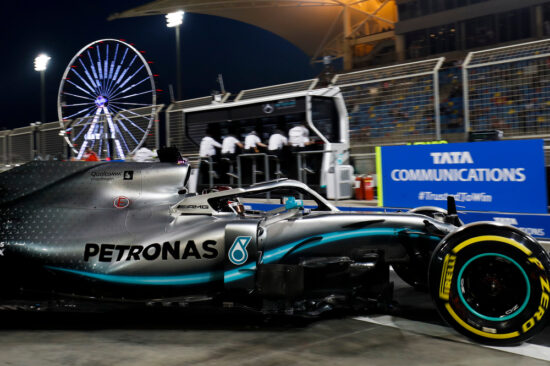With the F1 Monaco Grand Prix just around the corner, Mehul Kapadia examines the untapped commercial opportunities in the digital transformation of sports

As the circus of Formula 1 descends on Monaco this weekend, every spare inch of the tiny principality will be filled with enthusiastic F1 fans, keen to catch a glimpse of their favourite drivers. The audience following the race from elsewhere, however, will outnumber those on the French Riviera by many millions.
This is not unusual. For most major sporting events, the majority of spectators aren’t in the stadium, at the track, or on the course – they’re at home watching on television, following the action on their mobile, or a combination of the two.
Advances in digital technologies and social media have completely revolutionised the fan experience in recent years, enabling fans to watch and engage with sports in their terms – whether they’re actually at the venue or on the side of the globe.
But Tata Communications’ recent “Show Me The Money!” report highlights that sports organisations are only scratching the surface when it comes to monetising the huge opportunities that new digital platforms offer. Traditionally, revenue for sports comes from the sale of broadcasting rights, but the popularity of on-demand streaming means digitally engaged viewers now expect far more control over how and when they watch.
“All viewers, but especially younger viewers, expect to watch content any time, on any screen, and be able to pause, rewind or watch highlights,” notes Marcus Parnwell at DAZN in “Show Me the Money!”.

2019 Bahrain Grand Prix (Photo by Wolfgang Wilhelm)
DAZN is a dedicated sports streaming service that has capitalised on the evolution of the sporting landscape, first launching in parts of Europe in 2016 and expanding into the United States in 2018.
Traditional sports broadcasting also often fails to take into account the different elements of sports that turn casual viewers into die-hard fans. Fans are increasingly drawn to individuals, particularly those closer to home, and the stories they share on Instagram and Facebook, for example, is making global superstars feel more accessible than ever before.
“Focusing on the journeys of star drivers is one of our most powerful means of storytelling. Underdog stories, rivalries; these are universal,” explains Frank Arthofer of Formula 1. “Digital is a means of enhancing the conversation so more people tune in on race weekends.”
And that’s where the big monetisation opportunity lies: die-hard fans are more likely, than casual viewers, to spend money to see an event live, buy merchandise or subscribe to an OTT app.
Sports, such as football and Formula 1, have already built up a truly global audience, but digital technology can also help to reach fans in territories that aren’t yet catered for by existing distribution deals. TV rights tend to be sold on a country-by-country basis, but content owners can now use digital platforms such as their own OTT service, Facebook or YouTube to reach fans in regions that wouldn’t be considered worth serving under traditional distribution deals. Sometimes this might mean sharing highlights or even full coverage of must-see, unmissable races or matches, for free on social media to whet the appetite of people who are new to the sport, and help convert them into loyal followers.

2019 Bahrain Grand Prix (Photo by Zak Mauger / LAT Images)
Of course, there are things fans watching at home get that those actually at the events don’t, and digital can bridge that gap. Should F1 fans watching the Monaco Grand Prix on the other side of the world really have a better idea of what’s going on at the track than those who are on the ground? Thanks to increasingly sophisticated graphics and easy-to-digest data points, TV viewers are able to decipher the significance of every pitstop and DRS overtake – sometimes better than fans in the grandstand. Yet, something as simple as a spectator app and reliable Wi-Fi access at venues can augment the experience for those watching live. So, as the ‘remote’ digital fan experience gets better, the pressure is increased on venues to improve the sports experience for fans onsite too. Ultimately, attracting fans to the track or stadium is crucial for the commercial success of a sport, as broadcasters and sponsors want venues to be full and add to the atmosphere.
“Whether fans are keeping tabs on the action among the casinos and swimming pools of Monaco, at home on the sofa, in a bar with friends, or via their favourite driver’s Instagram Stories, digital technology presents an almost endless number of ways to monetise live sports’ enduring appeal.”
For Mehul’s views on the evolution of F1 during the last 1,000 Grands Prix, check out his recent blog post.
Tata Communications was the Official Connectivity Provider of Formula 1® between 2012 and 2019. Tata Communications was also the Official Managed Connectivity Supplier to Mercedes-AMG Petronas Motorsport, and Official Digital Transformation Partner to ROKiT Williams Racing until the end of the 2019 season.
Transformational Hybrid SolutionsOur cloud-enablement services offer the best performance on your traffic-heavy websites or mission-critical applications.
Core NetworksTata Communications™ global IT infrastructure and fibre network delivers the resources you need, when and where you need them.
Network Resources
Unified Communications As A ServiceBreak the barriers of borders efficiently and increase productivity with Tata Communications’ UC&C solutions.
Global SIP ConnectEmpower your business with our SIP network and witness it grow exponentially.
InstaCC™ - Contact Centre As A ServiceCloud contact centre solutions for digital customers experience and agent productivity.
DIGO – Communications Platform as a ServiceDIGO is an in-network cloud communications platform, enabling you to power up converged contextual human-to-everything conversations globally.
Unified Communication Resources Case studies, industry papers and other interesting content to help you explore our unified communications solution better.
IoT SolutionsThe Internet of Things is transforming the way we experience the world around us for good. Find out more about our Internet Of Things related solutions here.
Mobility SolutionsTata Communications’ mobility services enable your enterprise to maintain seamless communication across borders, with complete visibility of cost and usage.
Mobility & IoT Resources
Multi-Cloud SolutionsWith enterprises transitioning to a hybrid multi-cloud infrastructure, getting the right deployment model that yields ROI can be a daunting task.
Cloud ComplianceCompliant with data privacy standards across different countries and is also designed to protect customers’ privacy at all levels.
IZO™ Cloud Platform & ServicesIZO™ is a flexible, one-stop cloud enablement platform designed to help you navigate complexity for more agile business performance.
Managed Infrastructure ServicesIntegrated with our integrated Tier-1 network to help your business grow efficiently across borders.
Cloud PartnersWe support a global ecosystem for seamless, secure connectivity to multiple solutions through a single provider.
Cloud Resources
Governance, Risk, and ComplianceRisk and Threat management services to reduce security thefts across your business and improve overall efficiencies and costs.
Cloud SecurityBest-in-class security by our global secure web gateway helps provide visibility and control of users inside and outside the office.
Threat Management - SOCIndustry-leading threat-management service to minimise risk, with an efficient global solution against emerging security breaches and attacks.
Advanced Network SecurityManaged security services for a predictive and proactive range of solutions, driving visibility and context to prevent attacks.
Cyber Security ResourcesCase studies, industry papers and other interesting content to help you explore our securtiy solution better.
Hosted & Managed ServicesTata Communications provide new models for efficient wholesale carrier voice service management. With our managed hosting services make your voice business more efficient and better protected
Wholesale Voice Transport & Termination ServicesYour long-distance international voice traffic is in good hands. End-to-end, voice access & carrier services which includes voice transport and termination with a trusted, global partner.
Voice Access ServicesTata Communication’s provide solutions which take care of your carrier & voice services, from conferencing to call centre or business support applications.
Carrier Services Resources
CDN Acceleration ServicesOur CDN Web Site Acceleration (WSA) solution helps deliver static and dynamic content, guaranteeing higher performance for your website.
CDN SecuritySafeguard your website data and customers’ information by securing your website from hacks and other mala fide cyber activities.
Video CDNDeliver high-quality video content to your customers across platforms – website, app and OTT delivery.
CDN Resources
Elevate CXIncrease customer satisfaction while empowering your service team to deliver world-class customer experience and engagement.
Live Event ServicesTata Communications’ live event services help battle the share if eyeballs as on-demand video drives an explosion of diverse content available on tap for a global audience.
Media Cloud Infrastructure ServicesTata Communications’ media cloud infrastructure offers flexible storage & compute services to build custom media applications.
Global Media NetworkTata Communications’ global media network combines our expertise as a global tier-1 connectivity provider with our end-to-end media ecosystem.
Use CasesUse cases of Tata Communications’ Media Entertainment Services
Remote Production SolutionsMedia contribution, preparation and distribution are highly capital-intensive for producers of live TV and video content, and their workflows are complex.
Media Cloud Ecosystem SolutionsThe Tata Communications media cloud infrastructure services offer the basic building blocks for a cloud infrastructure-as-a-service.
Global Contribution & Distribution SolutionsTata Communications’ global contribution and distribution solution is built to reduce capital outlay and grow global footprint.
Satellite Alternative SolutionsAs more and more consumers choose to cut the cord & switch to internet-based entertainment options, broadcasters are faced with capital allocation decisions.
LeadershipA look into the pillars of Tata communications who carry the torch and are living embodiment of Tata’s values and ethos.
Culture & DiversityHere at Tata Communications we are committed to creating a culture of openness, curiosity and learning. We also believe in driving an extra mile to recognize new talent and cultivate skills.
OfficesA list of Tata Communications office locations worldwide.
SustainabilityTata Communications adopts a holistic approach and harnesses the power of new-age technologies like 5G, IoT and AI to build a sustainable digital world.
FAQCheck out our FAQs section for more information.
BoardHave a look at our board of members.
ResultsFind out more about our quarterly results.
Investor PresentationsFollow our repository of investor presentations.
FilingsGet all information regarding filings of Tata communications in one place.
Investor EventsAll investor related event schedule and information at one place.
GovernanceAt Tata, we believe in following our corporate social responsibility which is why we have set up a team for corporate governance.
SharesGet a better understanding of our shares, dividends etc.
SupportGet all investor related contact information here.


